|

In the year 1984, while celebrating the 100th anniversary of NCR (1884 to 1984), a set of books, only given out to NCR employees, has been issued. There were four different volumes covering:
- 1884 - 1922 The Cash Register era;
- 1923 - 1951 The Accounting Machine era;
- 1952 - 1984 The Computer era;
- 1985 and Beyond: The Information Society.
Here are some excerpts from these books. Just listen the words, which were told more then twenty years ago:
Celebrating the Future
One hundred years ago when NCR was founded, the fastest way to send messages was by telegraph. Today we communicate by semiconductor-driven computers and by satellite-based telecommunications networks. By the year 2000 we are likely to routinely send and receive information by laser beam. This new optical processing technology is only one of many sophisticated technologies which is propelling us into the information age of instant worldwide communication.
NCR’s Centennial year is an ideal time to celebrate what lies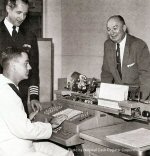 ahead. We think celebration is appropriate even though the only certainty about the unfolding information age is change. Thus, an exploration of the next two decades is a worthwhile but demanding exercise. The technological changes possible during this period may equal those of the entire previous century. These possibilities should be more than enough to stretch the imagination. They will require individuals, world citizens, companies and governments to confront difficult issues, make choices, and assume new responsibilities. And most importantly, because we are considering these issues now, we will be able to influence the direction of this emerging age, to some degree. Technology may be harnessed in many ways, and that means new choices. How each of us responds to these choices will determine not only how technology is applied, but how we will live the rest of our lives. ahead. We think celebration is appropriate even though the only certainty about the unfolding information age is change. Thus, an exploration of the next two decades is a worthwhile but demanding exercise. The technological changes possible during this period may equal those of the entire previous century. These possibilities should be more than enough to stretch the imagination. They will require individuals, world citizens, companies and governments to confront difficult issues, make choices, and assume new responsibilities. And most importantly, because we are considering these issues now, we will be able to influence the direction of this emerging age, to some degree. Technology may be harnessed in many ways, and that means new choices. How each of us responds to these choices will determine not only how technology is applied, but how we will live the rest of our lives.
Electronics Dominate Era
The final three decades of NCR’s first century were influenced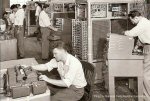 and finally dominated by electronic data processing technology, much as NCR’s first years had been shaped by revolutionary inventions for mechanical transaction processing. and finally dominated by electronic data processing technology, much as NCR’s first years had been shaped by revolutionary inventions for mechanical transaction processing.
And by 1970, as Dun’s business magazine bluntly put it, the moment of truth for NCR” had arrived. The still unanswered question was, “Can an 85-year-old cash register maker run with the computer crowd?” In the mid-1950s the company had released its first electronic products for the commercial market. Older mechanical products, however, continued to produce sales records. For many years this masked the staggering impact which the new technologies would have on the business machines industry and especially on NCR.
Facing a Vital Question
The march of technology following World War II produced many exotic new products. Among these, the computer was something of a paradox: Economist Leo Cherne said, “The computer is incredibly fast, accurate and stupid. Man is unbelievably slow, inaccurate and brilliant.” Its first applications were in scientific areas for “number-crunching” jobs. The commercial computer market began to emerge in 1953, but two years later the entire U.S. installed computer base was valued at only $250 million, and many foresaw only a limited commercial market. Yet by 1984 the commercial computer base was estimated to have reached $146 billion. new products. Among these, the computer was something of a paradox: Economist Leo Cherne said, “The computer is incredibly fast, accurate and stupid. Man is unbelievably slow, inaccurate and brilliant.” Its first applications were in scientific areas for “number-crunching” jobs. The commercial computer market began to emerge in 1953, but two years later the entire U.S. installed computer base was valued at only $250 million, and many foresaw only a limited commercial market. Yet by 1984 the commercial computer base was estimated to have reached $146 billion.
Stanley C. Allyn, NCR’s president, raised the vital question that faced the company in the early 1950s: Should NCR enter the electronic data processing field? “If (the answer was) yes,” he recalled, “we knew it meant many millions of research and development dollars, plus the retraining of manufacturing, marketing and service personnel. If the answer was no, we knew full well that future growth would be seriously limited. We would be living from then on with a ceiling on opportunity.” NCR’s affirmative answer to that vital question became evident in 1952.
Progressing Through Change
During its first 30 years, NCR Corporation entered the international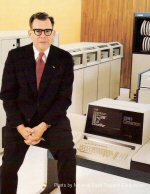 market and survived the economic “Panic of 1893,” succeeding recessions, attacks on its patents, a world war and political strife surrounding its international offices. By 1917, NCR had 95 percent of the world cash register market, and was cited as one of the top companies in the United States. Readers of Forbes Magazine of Business chose John H. Patterson, NCR’s founder and president, as one of the 50 most influential U.S. business leaders that year. On Patterson’s staff was a young accountant, Stanley C. Allyn, who would earn the same honor exactly 30 years later. market and survived the economic “Panic of 1893,” succeeding recessions, attacks on its patents, a world war and political strife surrounding its international offices. By 1917, NCR had 95 percent of the world cash register market, and was cited as one of the top companies in the United States. Readers of Forbes Magazine of Business chose John H. Patterson, NCR’s founder and president, as one of the 50 most influential U.S. business leaders that year. On Patterson’s staff was a young accountant, Stanley C. Allyn, who would earn the same honor exactly 30 years later.
Yet, a critical challenge to the company’s future was about to occur: to create demand for an entirely new product in the U.S. and world markets. Conditions for NCR to move into the second period, the “accounting machine era,” were favorable, since NCR products were leaders in the business equipment market. Product evolution in the early 1920s was moving toward more complex transaction processing, and was driven by the needs of users in retailing, hotels, railroads, banking and other industries. Not only did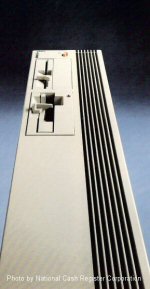 NCR engineers continue to introduce product improvements that met user needs; but they also created the demands of the marketplace. NCR engineers continue to introduce product improvements that met user needs; but they also created the demands of the marketplace.
A ‘Giant’ in Sales
During this middle period, the fortunes of the company were more closely tied to external events than they had been previously. The stock market crash in October 1929, the Great Depression, a decade of adverse conditions that followed, and World War II had a powerful impact on the multinational business. By comparison, times were tranquil when the accounting machine era began. Leading the company in 1922 were Frederick B. Patterson, president; Stanley C. Allyn, then comptroller and a director; and John H. Barringer, general manager.
Frederick, John Patterson’s son, “retained the presidency and exercised voting control over the enterprise,” according to Allyn’s memoirs, while Barringer and Allyn spearheaded the company in its first significant diversification effort with the Class 2000 accounting machine, “a sophisticated cash register that printed data on inserted forms and provided 30 totals rather than half a dozen.” NCR’s sales in 1921 were $29 million with profits of $2.8 million. By 1925, sales had increased to $45 million.
A Formidable Foundation
For a multinational business enterprise to survive and prosper over a century is an achievement attained by only the few who can weather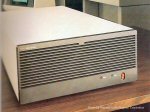 revolutions, wars, extreme fluctuations of many nations’ economies, and the changing values of their peoples. The odds were slim that NCR would survive and prosper for 100 years. Equally unusual is that NCR was founded because there was a need for accurate processing of business information, and that to this day, the company remains a world leader in an industry which provides some $100 billion in products and services annually. revolutions, wars, extreme fluctuations of many nations’ economies, and the changing values of their peoples. The odds were slim that NCR would survive and prosper for 100 years. Equally unusual is that NCR was founded because there was a need for accurate processing of business information, and that to this day, the company remains a world leader in an industry which provides some $100 billion in products and services annually.
Today, NCR develops markets and services a wide range of computer and terminal systems, office automation products, micrographic systems, data processing and telecommunications services, semiconductor components, operating and applications software, and business forms and supplies. The people who founded the company are gone. Their ideas, however, had an aspect of soundness which has served the company well for 100 years. Evidence of the soundness of those ideas can be seen in NCR’s century of success and in the fact that the ideas were adopted by many companies worldwide as standard practices. The following pages describe some of these ideas and the people who turned them into reality.
Leadership: Ingredient for Success
John Henry Patterson, NCR Corporation’s founding president and chairman of the board, is best remembered, first, for recognizing the potential of the mechanical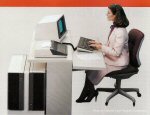 cash register, and second, for creating a market for his product with innovative sales and marketing techniques. He is also remembered for his innovative programs which addressed the well-being of his employees and his community. cash register, and second, for creating a market for his product with innovative sales and marketing techniques. He is also remembered for his innovative programs which addressed the well-being of his employees and his community.
Three days after his seemingly ill-advised purchase of the National Manufacturing Company in December 1884, John Patterson began to contact sales agents around the country. “Anyone could be an agent and get a commission if he made a sale,” according to an early Patterson biographer. “There was no money for salaries, so sales agents were put on commission. They didn’t want to sell on a full-time basis until Patterson gave each an exclusive territory” and promised not to cut their commissions.
Under previous ownership, the National company sold only 359 cash registers (the models without bell, drawer and receipt) through 1884. Robert Callahan, based in Washington, D.C., was National’s only regular agent. Callahan stayed on with the new National Cash Register Company and received “three rouzing (sic) cheers” as the first NCR agent at the 1888 sales convention.
|

